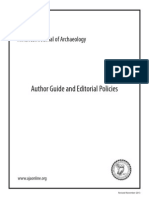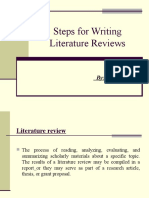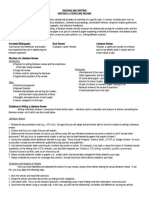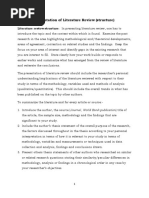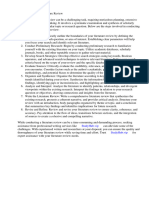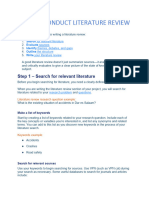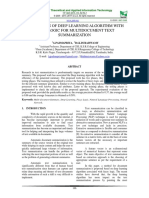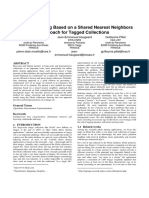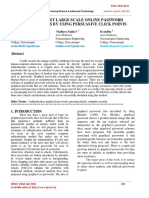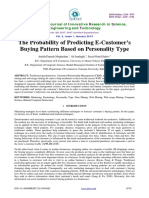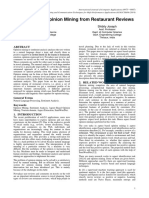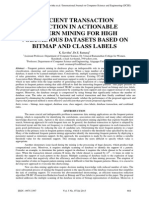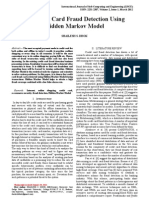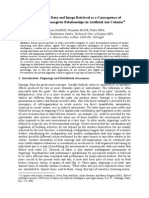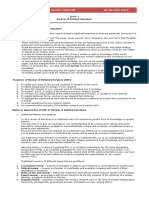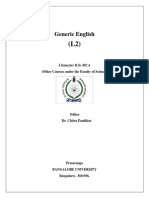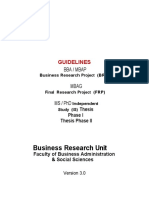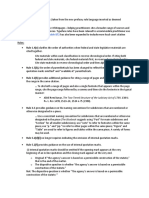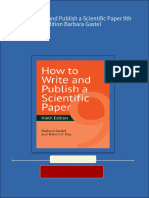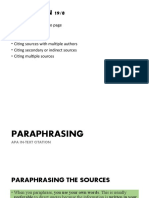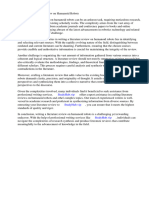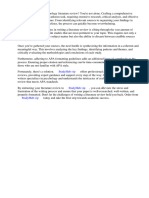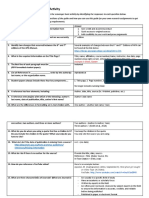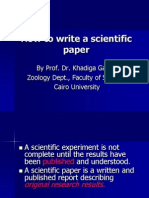0 ratings0% found this document useful (0 votes)
55 viewsGuidelines For Writing A Literature Review
Guidelines For Writing A Literature Review
Uploaded by
Ninad SamelThe document provides guidelines for writing a literature review, including defining what a literature review is, outlining a step-by-step process, and giving tips for analyzing literature. It details finding relevant sources, taking notes, identifying trends, and relating studies to create a critical analysis of the research topic.
Copyright:
© All Rights Reserved
Available Formats
Download as DOCX, PDF, TXT or read online from Scribd
Guidelines For Writing A Literature Review
Guidelines For Writing A Literature Review
Uploaded by
Ninad Samel0 ratings0% found this document useful (0 votes)
55 views7 pagesThe document provides guidelines for writing a literature review, including defining what a literature review is, outlining a step-by-step process, and giving tips for analyzing literature. It details finding relevant sources, taking notes, identifying trends, and relating studies to create a critical analysis of the research topic.
Original Title
Guidelines for Writing a Literature Review
Copyright
© © All Rights Reserved
Available Formats
DOCX, PDF, TXT or read online from Scribd
Share this document
Did you find this document useful?
Is this content inappropriate?
The document provides guidelines for writing a literature review, including defining what a literature review is, outlining a step-by-step process, and giving tips for analyzing literature. It details finding relevant sources, taking notes, identifying trends, and relating studies to create a critical analysis of the research topic.
Copyright:
© All Rights Reserved
Available Formats
Download as DOCX, PDF, TXT or read online from Scribd
Download as docx, pdf, or txt
0 ratings0% found this document useful (0 votes)
55 views7 pagesGuidelines For Writing A Literature Review
Guidelines For Writing A Literature Review
Uploaded by
Ninad SamelThe document provides guidelines for writing a literature review, including defining what a literature review is, outlining a step-by-step process, and giving tips for analyzing literature. It details finding relevant sources, taking notes, identifying trends, and relating studies to create a critical analysis of the research topic.
Copyright:
© All Rights Reserved
Available Formats
Download as DOCX, PDF, TXT or read online from Scribd
Download as docx, pdf, or txt
You are on page 1of 7
Guidelines for writing a literature review
by Helen Mongan-Rallis. Last updated: November 17, 2006
[Note: For these guidelines, in some sections I have quoted directly some of the the
steps from: Galvan, J. (2006). Writing literature reviews: a guide for students of the
behavioral sciences (3rd ed.). Glendale, CA: Pyrczak Publishing.]
What is a literature review?
A literature review is not an annotated bibliography in which you summarize briefly
each article that you have reviewed. While a summary of the what you have read is
contained within the literature review, it goes well beyond merely summarizing
professional literature. It focuses on a specific topic of interest to you and includes
a critical analysis of the relationship among different works, and relating this research
to your work. It may be written as a stand-alone paper or to provide a theoretical
framework and rationale for a research study (such as a thesis or dissertation).
Step-by-step guide
These guidelines are adapted primarily from Galvan (2006). Galvan outlines a very
clear, step-by-step approach that is very useful to use as you write your review. I have
integrated some other tips within this guide, particularly in suggesting different
technology tools that you might want to consider in helping you organize your review.
In the sections from Step 6-9 what I have included is the outline of those steps exactly
as described by Galvan. I also provide links at the end of this guide to resources that
you should use in order to search the literature and as you write your review.
In addition to using the step-by-step guide that I have provided below, I also
recommend that you (a) locate examples of literature reviews in your field of study
and skim over these to get a feel for what a literature review is and how these are
written (I have also provided links to a couple of examples at the end of these
guidelines (b) read over other guides to writing literature reviews so that you see
different perspectives and approaches: Some examples are:
1. Review of Literature: University of Wisconsin - Madison The Writing Center.
2. How to ..Write a Literature Review: University of California, Santa Cruz
University Library).
3. Information Fluency - Literature Review: Washington & Lee University
4. How to Do A Literature Review? North Carolina A&T State University F.D.
Bluford Library.
5. Writing up research: using the literature. Language Center, Asian Institute of
Technology (Thailand).
6. Selected Links to Resources on Writing a Literature Review
Step 1: Review APA guidelines
Read through the links provided below on APA guidelines so that you become
familiar with the common core elements of how to write in APA style: in particular,
pay attention to general document guidelines (e.g. font, margins, spacing), title page,
abstract, body, text citations, quotations.
Step 2: Decide on a topic
It will help you considerably if your topic for your literature review is the one on
which you intend to do your final M.Ed. project, or is in some way related to the topic
of your final project. However, you may pick any scholarly topic.
Step 3: Identify the literature that you will review:
1. Familiarize yourself with online databases (see UMD library resource links
below for help with this), identifying relevant databases in your field of study.
2. Using relevant databases, search for literature sources using Google Scholar
and also searching using Furl (search all sources, including the Furl accounts of
other Furl members). Some tips for identifying suitable literature and
narrowing your search :
1. Start with a general descriptor from the database thesaurus or one that
you know is already a well defined descriptor based on past work that
you have done in this field. You will need to experiment with different
searches, such as limiting your search to descriptors that appear only in
the document titles, or in both the document title and in the abstract.
2. Redefine your topic if needed: as you search you will quickly find out if
the topic that you are reviewing is too broad. Try to narrow it to a
specific area of interest within the broad area that you have chosen
(remember: this is merely an introductory literature review for Educ
7001). It is a good idea, as part of your literature search, to look for
existing literature reviews that have already been written on this topic.
3. As part of your search, be sure to identify landmark or classic studies
and theorists as these provide you with a framework/context for your
study.
3. Import your references into your RefWorks account (see: Refworks Import
Directions for guide on how to do this from different databases). You can also
enter references manually into RefWorks if you need to.
Step 4: Analyze the literature
Once you have identified and located the articles for your review, you need to analyze
them and organize them before you begin writing:
1. Overview the articles: Skim the articles to get an idea of the general purpose
and content of the article (focus your reading here on the abstract, introduction
and first few paragraphs, the conclusion of each article. Tip: as you skim the
articles, you may want to record the notes that you take on each directly into
RefWorks in the box for User 1. You can take notes onto note cards or into a
word processing document instead or as well as using RefWorks, but having
your notes in RefWorks makes it easy to organize your notes later.
2. Group the articles into categories (e.g. into topics and subtopics and
chronologically within each subtopic). Once again, it's useful to enter this
information into your RefWorks record. You can record the topics in the same
box as before (User 1) or use User 2 box for the topic(s) under which you have
chosen to place this article.
3. Take notes:
1. Decide on the format in which you will take notes as you read the
articles (as mentioned above, you can do this in RefWorks. You can also
do this using a Word Processor, or a concept mapping program like
Inspiration (free 30 trial download), a data base program (e.g. Access or
File Maker Pro), in an Excel spreadsheet, or the "old-fashioned" way of
using note cards. Be consistent in how you record notes.
2. Define key terms: look for differences in the way keys terms are defined
(note these differences).
3. Note key statistics that you may want to use in the introduction to your
review.
4. Select useful quotes that you may want to include in your
review. Important: If you copy the exact words from an article, be sure
to cite the page number as you will need this should you decide to use
the quote when you write your review (as direct quotes must always be
accompanied by page references). To ensure that you have quoted
accurately (and to save time in note taking), if you are accessing the
article in a format that allows this, you can copy and paste using your
computer "edit --> copy --> paste" functions. Note: although you may
collect a large number of quotes during the note taking phase of your
review, when you write the review, use quotes very sparingly. The rule I
follow is to quote only when when some key meaning would be lost in
translation if I were to paraphrase the original author's words, or if using
the original words adds special emphasis to a point that I am making.
5. Note emphases, strengths & weaknesses: Since different research studies
focus on different aspects of the issue being studied, each article that you
read will have different emphases, strengths. and weaknesses. Your role
as a reviewer is to evaluate what you read, so that your review is not a
mere description of different articles, but rather a critical analysis that
makes sense of the collection of articles that you are reviewing. Critique
the research methodologies used in the studies, and distinguish between
assertions (the author's opinion) and actual research findings (derived
from empirical evidence).
6. Identify major trends or patterns: As you read a range of articles on your
topic, you should make note of trends and patterns over time as reported
in the literature. This step requires you to synthesize and make sense of
what you read, since these patterns and trends may not be spelled out in
the literature, but rather become apparent to you as you review the big
picture that has emerged over time. Your analysis can make
generalizations across a majority of studies, but should also note
inconsistencies across studies and over time.
7. Identify gaps in the literature, and reflect on why these might exist
(based on the understandings that you have gained by reading literature
in this field of study). These gaps will be important for you to address as
you plan and write your review.
8. Identify relationships among studies: note relationships among studies,
such as which studies were landmark ones that led to subsequent studies
in the same area. You may also note that studies fall into different
categories (categories that you see emerging or ones that are already
discussed in the literature). When you write your review, you should
address these relationships and different categories and discuss relevant
studies using this as a framework.
9. Keep your review focused on your topic: make sure that the articles you
find are relevant and directly related to your topic. As you take notes,
record which specific aspects of the article you are reading are relevant
to your topic (as you read you will come up with key descriptors that you
can record in your notes that will help you organize your findings when
you come to write up your review). If you are using an electronic form
of note taking, you might note these descriptors in a separate field (e.g.
in RefWorks, put these under User 2 or User 3; in Excel have a separate
column for each descriptor; if you use Inspiration, you might attach a
separate note for key descriptors.
10. Evaluate your references for currency and coverage: Although you can
always find more articles on your topic, you have to decide at what point
you are finished with collecting new resources so that you can focus on
writing up your findings. However, before you begin writing, you must
evaluate your reference list to ensure that it is up to date and has reported
the most current work. Typically a review will cover the last five years,
but should also refer to any landmark studies prior to this time if they
have significance in shaping the direction of the field. If you include
studies prior to the past five years that are not landmark studies, you
should defend why you have chosen these rather than more current ones.
Step 5: Summarize the literature in table or concept map format
1. Galvan (2006) recommends building tables as a key way to help you overview,
organize, and summarize your findings, and suggests that including one or
more of the tables that you create may be helpful in your literature review. If
you do include tables as part of your review each must be accompanied by an
analysis that summarizes, interprets and synthesizes the literature that you have
charted in the table. You can plan your table or do the entire summary chart of
your literature using a concept map (such as using Inspiration)
1. You can create the table using the table feature within Microsoft Word,
or can create it initially in Excel and then copy and paste/import the the
Excel sheet into Word once you have completed the table in Excel. The
advantage of using Excel is that it enables you to sort your findings
according to a variety of factors (e.g. sort by date, and then by author;
sort by methodology and then date)
2. Examples of tables that may be relevant to your review:
1. Definitions of key terms and concepts.
2. Research methods
3. Summary of research results
Step 6: Synthesize the literature prior to writing your review
Using the notes that you have taken and summary tables, develop an outline of your
final review. The following are the key steps as outlined by Galvan (2006: 71-79)
1. Consider your purpose and voice before beginning to write. In the case of this
Educ 7001 introductory literature review, your initial purpose is to provide an
overview of the topic that is of interest to you, demonstrating your
understanding of key works and concepts within your chosen area of focus.
You are also developing skills in reviewing and writing, to provide a
foundation on which you will build in subsequent courses within your M.Ed.
and ultimately in your final project. In your final project your literature review
should demonstrate your command of your field of study and/or establishing
context for a study that you have done.
2. Consider how you reassemble your notes: plan how you will organize your
findings into a unique analysis of the picture that you have captured in your
notes. Important: A literature review is not series of annotations (like an
annotated bibliography). Galvan (2006:72) captures the difference between an
annotated bibliography and a literature review very well: "...in essence, like
describing trees when you really should be describing a forest. In the case of a
literature review, you are really creating a new forest, which you will build by
using the trees you found in the literature you read."
3. Create a topic outline that traces your argument: first explain to the reader your
line or argument (or thesis); then your narrative that follows should explain and
justify your line of argument. You may find the program Inspiration useful in
mapping out your argument (and once you have created this in a concept map
form, Inspiration enables you to convert this to a text outline merely by clicking
on the "outline" button). This can then be exported into a Microsoft Word
document.
4. Reorganize your notes according to the path of your argument
5. Within each topic heading, note differences among studies.
6. Within each topic heading, look for obvious gaps or areas needing more
research.
7. Plan to describe relevant theories.
8. Plan to discuss how individual studies relate to and advance theory
9. Plan to summarize periodically and, again near the end of the review
10. Plan to present conclusions and implications
11. Plan to suggest specific directions for future research near the end of the review
12. Flesh out your outline with details from your analysis
Step 7: Writing the review (Galvan, 2006: 81-90)
1. Identify the broad problem area, but avoid global statements
2. Early in the review, indicate why the topic being reviewed is important
3. Distinguish between research finding and other sources of information
4. Indicate why certain studies are important
5. If you are commenting on the timeliness of a topic, be specific in describing the
time frame
6. If citing a classic or landmark study, identify it as such
7. If a landmark study was replicated, mention that and indicate the results of the
replication
8. Discuss other literature reviews on your topic
9. Refer the reader to other reviews on issues that you will not be discussing in
details
10. Justify comments such as, "no studies were found."
11. Avoid long lists of nonspecific references
12. If the results of previous studies are inconsistent or widely varying, cite them
separately
13. Cite all relevant references in the review section of thesis, dissertation, or
journal article
Step 8: Developing a coherent essay (Galvan, 2006: 91-96)
1. If your review is long, provide an overview near the beginning of the review
2. Near the beginning of a review, state explicitly what will and will not be
covered
3. Specify your point of view early in the review: this serves as the thesis
statement of the review.
4. Aim for a clear and cohesive essay that integrates the key details of the
literature and communicates your point of view (a literature is not a series of
annotated articles).
5. Use subheadings, especially in long reviews
6. Use transitions to help trace your argument
7. If your topic teaches across disciplines, consider reviewing studies from each
discipline separately
8. Write a conclusion for the end of the review: Provide closure so that the path of
the argument ends with a conclusion of some kind. How you end the review,
however, will depend on your reason for writing it. If the review was written to
stand alone, as is the case of a term paper or a review article for publication, the
conclusion needs to make clear how the material in the body of the review has
supported the assertion or proposition presented in the introduction. On the
other hand, a review in a thesis, dissertation, or journal article presenting
original research usually leads to the research questions that will be addressed.
9. Check the flow of your argument for coherence.
Reference:
You might also like
- 1-Guidelines For Writing A Literature ReviewDocument41 pages1-Guidelines For Writing A Literature ReviewStephand Bob'z ArdyNo ratings yet
- Guidelines For Writing A Literature ReviewDocument6 pagesGuidelines For Writing A Literature ReviewJR Deviente50% (2)
- EthicalDocument19 pagesEthicalhelenxiaochingNo ratings yet
- Writing A Literature ReviewDocument16 pagesWriting A Literature ReviewChristian TaguinodNo ratings yet
- Syllabus - Intro To African-American Studies (AAST 200)Document7 pagesSyllabus - Intro To African-American Studies (AAST 200)mathenyrNo ratings yet
- AJA Bibliography InstructionsDocument37 pagesAJA Bibliography InstructionsValia GeorgedakiNo ratings yet
- Guidelines For Writing A Literature ReviewDocument6 pagesGuidelines For Writing A Literature ReviewDr See Kin HaiNo ratings yet
- Guidelines For Writing A Literature ReviewDocument7 pagesGuidelines For Writing A Literature ReviewNadia0% (1)
- Guidelines For Writing A Literature ReviewDocument8 pagesGuidelines For Writing A Literature ReviewJackNo ratings yet
- How To Write A Lit Review-Univ of MinnesotaDocument6 pagesHow To Write A Lit Review-Univ of MinnesotaMadiha SalamNo ratings yet
- Guidelines For Writing A Literature ReviewDocument7 pagesGuidelines For Writing A Literature ReviewAnne BiagtanNo ratings yet
- Guidelines For Writing A Literature ReviewDocument6 pagesGuidelines For Writing A Literature ReviewmoeknupNo ratings yet
- Guidelines For Writing A Literature ReviewDocument5 pagesGuidelines For Writing A Literature ReviewRoy FloresNo ratings yet
- Guidelines For Writing A Literature ReviewDocument6 pagesGuidelines For Writing A Literature ReviewagileengrNo ratings yet
- Literature ReviewDocument8 pagesLiterature ReviewLeanneDwayne AlefanteNo ratings yet
- Literature ReviewDocument9 pagesLiterature ReviewSameen BaberNo ratings yet
- How To Write A Literature ReviewDocument6 pagesHow To Write A Literature ReviewSam100% (4)
- Microbiology and Parasitology SDL 1Document3 pagesMicrobiology and Parasitology SDL 1Dustu ImalaNo ratings yet
- Practical Research 2 Quarter 2 Week 2 March 22-26, 2021Document31 pagesPractical Research 2 Quarter 2 Week 2 March 22-26, 2021mary grace maninantanNo ratings yet
- What Is A Literature Review With Subheadings ExampleDocument9 pagesWhat Is A Literature Review With Subheadings Examplec5rqq644No ratings yet
- Steps For Writing Literature Reviews: By: Group-2Document20 pagesSteps For Writing Literature Reviews: By: Group-2safdarnazeerNo ratings yet
- How To Do A Literature Review (Describe The Steps)Document5 pagesHow To Do A Literature Review (Describe The Steps)ea59j0hqNo ratings yet
- How Write RRLDocument26 pagesHow Write RRLhaydee_hitcul13No ratings yet
- Literature ReviewDocument53 pagesLiterature ReviewJC NicdaoNo ratings yet
- How To Write A Literature Review AmazonDocument7 pagesHow To Write A Literature Review Amazonc5pdd0qg100% (1)
- How To Organize Articles For Literature ReviewDocument7 pagesHow To Organize Articles For Literature Reviewcmaqqsrif100% (1)
- Lit ReviewDocument22 pagesLit ReviewCindy Lou LawasNo ratings yet
- Chapter ResearchDocument78 pagesChapter ResearchAnzai hazeNo ratings yet
- RW Last 2nd QuarterDocument6 pagesRW Last 2nd QuarterJaja CabaticNo ratings yet
- 1 Collapse AllDocument3 pages1 Collapse AllmknightNo ratings yet
- Raguindin, Lansang Literature PowerpointDocument23 pagesRaguindin, Lansang Literature Powerpointsoleilramirez217No ratings yet
- Apa Literature Review Section HeadingsDocument8 pagesApa Literature Review Section Headingsea3c5mfq100% (1)
- 10 Literature-ReviewDocument21 pages10 Literature-ReviewHannah DyNo ratings yet
- What To Include in A Good Literature ReviewDocument5 pagesWhat To Include in A Good Literature Reviewc5kby94s100% (1)
- What Should A Review of Related Literature ContainDocument5 pagesWhat Should A Review of Related Literature ContainafdtbwkhbNo ratings yet
- Presentation of Literature Review Lesson Four-1Document22 pagesPresentation of Literature Review Lesson Four-1HudahNo ratings yet
- How To Choose Articles For Literature ReviewDocument4 pagesHow To Choose Articles For Literature Reviewea86yezd100% (1)
- r3 Methods of ResearchDocument49 pagesr3 Methods of Researchsuzannevillasis19No ratings yet
- 1° Summary: Educational Research, Chapter 3 - Reviewing The LiteratureDocument4 pages1° Summary: Educational Research, Chapter 3 - Reviewing The LiteratureareszNo ratings yet
- How Do You Reference in A Literature ReviewDocument7 pagesHow Do You Reference in A Literature Reviewaflsmceoc100% (1)
- Literature ReviewDocument6 pagesLiterature Reviewsoleilramirez217No ratings yet
- Stages in Writing A Literature ReviewDocument8 pagesStages in Writing A Literature Reviewafdttqbna100% (1)
- LESSON 5: Review of Related Literature and APA CitationDocument21 pagesLESSON 5: Review of Related Literature and APA CitationAdrian CamasosaNo ratings yet
- LESSON 5: Review of Related Literature and APA CitationDocument21 pagesLESSON 5: Review of Related Literature and APA CitationAdrian CamasosaNo ratings yet
- Annotation and Works Cited Page Assignment: Submit by February 14, 2018Document2 pagesAnnotation and Works Cited Page Assignment: Submit by February 14, 2018John L KankhuniNo ratings yet
- L 3 Literature ReviewDocument39 pagesL 3 Literature ReviewTonie NascentNo ratings yet
- Steps For Doing A Literature ReviewDocument8 pagesSteps For Doing A Literature Reviewafmaamehdbosuo100% (1)
- Literature ReviewDocument24 pagesLiterature Reviewمرتضى محمد منصورNo ratings yet
- ResearchDocument4 pagesResearchdanrex barbazaNo ratings yet
- Tips For Writing A Literature ReviewDocument5 pagesTips For Writing A Literature Reviewaflsrxfoe100% (1)
- Literature Review Structure OutlineDocument7 pagesLiterature Review Structure Outlineea2pbjqk100% (1)
- Basic Article Review Writing RulesDocument11 pagesBasic Article Review Writing Ruleskelemework dagneNo ratings yet
- Steps For A Literature ReviewDocument6 pagesSteps For A Literature Reviewafdtalblw100% (1)
- What Is A Literature Review? Further ReadingDocument2 pagesWhat Is A Literature Review? Further ReadingMia SamNo ratings yet
- Tips To Write Literature Review For ThesisDocument5 pagesTips To Write Literature Review For Thesisc5pcnpd6100% (1)
- What Should Be Included in A Good Literature ReviewDocument6 pagesWhat Should Be Included in A Good Literature ReviewafdtywgduNo ratings yet
- Literature Review With SubheadingsDocument6 pagesLiterature Review With Subheadingsafmztwoalwbteq100% (1)
- General Steps For Writing A Literature ReviewDocument4 pagesGeneral Steps For Writing A Literature Reviewc5qrar20100% (1)
- Tips To Write A Literature ReviewDocument8 pagesTips To Write A Literature Reviewea726gej100% (1)
- Chapter 2Document28 pagesChapter 2roxanmecateNo ratings yet
- What Headings Should Be Included in A Literature ReviewDocument8 pagesWhat Headings Should Be Included in A Literature Reviewc5rr5sqwNo ratings yet
- How To Conduct Literature ReviewDocument6 pagesHow To Conduct Literature Reviewraphaelmrema110No ratings yet
- Understanding Essay Writing: A Guide To Writing Essays By Someone Who Grades ThemFrom EverandUnderstanding Essay Writing: A Guide To Writing Essays By Someone Who Grades ThemRating: 4 out of 5 stars4/5 (4)
- 22Vol62No1 PDFDocument8 pages22Vol62No1 PDFNinad SamelNo ratings yet
- Employee Monitoring System PDFDocument4 pagesEmployee Monitoring System PDFNinad SamelNo ratings yet
- A Novel Approach For Data Clustering Using Improved K-Means Algorithm PDFDocument6 pagesA Novel Approach For Data Clustering Using Improved K-Means Algorithm PDFNinad SamelNo ratings yet
- Fibonacci Series PDFDocument4 pagesFibonacci Series PDFNinad SamelNo ratings yet
- Message Security Using Armstrong Number and Authentication Using Color PDFDocument5 pagesMessage Security Using Armstrong Number and Authentication Using Color PDFNinad SamelNo ratings yet
- Image Clustering Based On A Shared Nearest Neighbors Approach For Tagged CollectionsDocument10 pagesImage Clustering Based On A Shared Nearest Neighbors Approach For Tagged CollectionsNinad SamelNo ratings yet
- Authenticated Key Exchange Protocols For Parallel PDFDocument14 pagesAuthenticated Key Exchange Protocols For Parallel PDFNinad SamelNo ratings yet
- Defenses Against Large Scale Online Password PDFDocument6 pagesDefenses Against Large Scale Online Password PDFNinad SamelNo ratings yet
- Customer Behaviour Prediction Using Web Usage MiningDocument5 pagesCustomer Behaviour Prediction Using Web Usage MiningNinad SamelNo ratings yet
- Aspect Based Opinion Mining From Restaurant Reviews PDFDocument4 pagesAspect Based Opinion Mining From Restaurant Reviews PDFNinad Samel100% (1)
- Graphical Password Authentication Using Persuasive Cued Click PointDocument31 pagesGraphical Password Authentication Using Persuasive Cued Click PointNinad SamelNo ratings yet
- Credit Card FraudDocument13 pagesCredit Card FraudNinad SamelNo ratings yet
- Efficient Transaction Reduction in Actionable Pattern Mining For High Voluminous Datasets Based On Bitmap and Class LabelsDocument8 pagesEfficient Transaction Reduction in Actionable Pattern Mining For High Voluminous Datasets Based On Bitmap and Class LabelsNinad SamelNo ratings yet
- Credit Card Fraud Detection Using Hidden Markov ModelsDocument5 pagesCredit Card Fraud Detection Using Hidden Markov ModelsNinad SamelNo ratings yet
- A ClusterDocument10 pagesA ClusterNinad SamelNo ratings yet
- Android Travel Mate Application With OCR & Language TranslationDocument8 pagesAndroid Travel Mate Application With OCR & Language TranslationNinad SamelNo ratings yet
- Unit 4 NotesDocument7 pagesUnit 4 NotesAlieza DelarayaNo ratings yet
- ITDG 8535 Economic Statecraft Fall 2017Document11 pagesITDG 8535 Economic Statecraft Fall 2017Tareq Tareq TareqNo ratings yet
- Example of A Graduate Level Literature ReviewDocument7 pagesExample of A Graduate Level Literature Reviewafmzwrhwrwohfn100% (1)
- Generic English (Grammer Book) - 1st Sem BCADocument92 pagesGeneric English (Grammer Book) - 1st Sem BCARax RavNo ratings yet
- Comparison of PubMed, Scopus, Web of Science, and Google Scholar - Strengths and WeaknessesDocument5 pagesComparison of PubMed, Scopus, Web of Science, and Google Scholar - Strengths and WeaknessesMostafa AbdelrahmanNo ratings yet
- In Text CitationDocument1 pageIn Text Citationapi-264639690No ratings yet
- Guidelines For BRP FRP IS Thesis V3Document37 pagesGuidelines For BRP FRP IS Thesis V3aon aliNo ratings yet
- Literature Review-Pinal Na PagsusulitDocument8 pagesLiterature Review-Pinal Na PagsusulitMarc Anthony ManzanoNo ratings yet
- BCU Harvard Referencing Guidelines Version 1st September 2019Document115 pagesBCU Harvard Referencing Guidelines Version 1st September 2019lucky414No ratings yet
- Bluebook 20TH EdDocument4 pagesBluebook 20TH EdBilalNo ratings yet
- Get How To Write and Publish A Scientific Paper 9th Edition Barbara Gastel Free All ChaptersDocument79 pagesGet How To Write and Publish A Scientific Paper 9th Edition Barbara Gastel Free All Chaptersmiddlegunong58100% (2)
- Harvard-Referencing - Quick-Guide - London Metropolitan University PDFDocument3 pagesHarvard-Referencing - Quick-Guide - London Metropolitan University PDFRama SahaNo ratings yet
- Chapter 1 HandoutDocument3 pagesChapter 1 HandoutGrace MendozaNo ratings yet
- Owen and Sawhill WorksheetDocument2 pagesOwen and Sawhill WorksheetJaz & DreNo ratings yet
- PARAPHRASINGDocument12 pagesPARAPHRASINGaciara chanNo ratings yet
- Final Paper Assignment InstructionsDocument2 pagesFinal Paper Assignment Instructionsburakgebze5441No ratings yet
- Literature Review of Humanoid RobotDocument4 pagesLiterature Review of Humanoid Robotafdtsebxc100% (1)
- Environmental Security Syllabus Peace An PDFDocument10 pagesEnvironmental Security Syllabus Peace An PDFAri El0% (1)
- NewSyllabus 21362020101403837 PDFDocument3 pagesNewSyllabus 21362020101403837 PDFMelita Stephen NatalNo ratings yet
- CSE Citation Style - Quick Guide: 7th EditionDocument10 pagesCSE Citation Style - Quick Guide: 7th EditioncherukurajuNo ratings yet
- The Principles of Biomedical Scientific Writing: CitationDocument7 pagesThe Principles of Biomedical Scientific Writing: CitationJosue Guerra CruzNo ratings yet
- Apa Citation ThesisDocument6 pagesApa Citation Thesissummeryoungnorthlasvegas100% (2)
- APA 7th Edition 1Document81 pagesAPA 7th Edition 1Erika AfrielNo ratings yet
- Psychology Literature Review Example ApaDocument5 pagesPsychology Literature Review Example Apaafdtytird100% (1)
- APA Scavenger Hunt AnswersDocument2 pagesAPA Scavenger Hunt AnswerssdasadNo ratings yet
- How To Write A Scientific PaperDocument39 pagesHow To Write A Scientific PaperManish Chandra Prabhakar0% (1)
- PHIL10003 Take Home Exam 2019Document3 pagesPHIL10003 Take Home Exam 2019Calvin NestNo ratings yet





